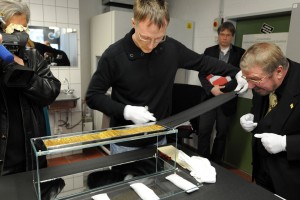In 1756, King Alaungphaya of Burma sent a letter to King George II of Britain. Written in Burmese script, the letter was engraved on a gold sheet and decorated with 24 rubies then encased in an elephant tusk for delivery, but despite its designed-to-impress packaging, nobody at King George’s court could read the language so in 1758 George forwarded it to the Royal Public Library (formerly the private collection of the Dukes of Hanover, then their official government library, then once the elector of Hanover became King of England, styled the Royal Public Library) in his hometown of Hanover, Germany, for archiving.
The letter remained in a vault in Hanover for 250 years, mainly unremarked although Danish King Christian VII saw it in 1768. It would have been better he hadn’t because he damaged it in handling making the text even harder to decipher.
 Three years ago historians at what is today known as the Gottfried Wilhelm Leibniz Library, after the famous mathematician and philosopher who was also its head librarian between 1676 and 1716, revived the long-dormant golden letter and set about finally deciphering it.
Three years ago historians at what is today known as the Gottfried Wilhelm Leibniz Library, after the famous mathematician and philosopher who was also its head librarian between 1676 and 1716, revived the long-dormant golden letter and set about finally deciphering it.
Amid the valuable gems and flowery language, King Alaungphaya confirms his permission for a harbour to be built in the city of Pathein to encourage trading co-operation between the two countries. Written in Burmese script, it is addressed to “the most meritorious and supreme [king] master of all the parasol-bearing kings … lord of ruby, gold, silver, copper, iron, amber and precious stone mines, lord of white elephants, red elephants and elephants of various colours”.
It goes on to convey “kindest greetings to the English king who rules over the English capital”.
The letter, which was contained in an elephant tusk, referred to the presence in Burma of Henry Brooke, a British envoy working for the British East India Company who was in charge of the settlement in Pathein.
It went on: “Following the humble request of your esteemed Highness’ envoy, Mr Henry Brooke, We have granted the site for your ships in Pathein at the place he wanted.
“A sealed royal order was sent to the officer of the English king and the governor of Pathein was instructed to measure and hand over [the piece of land] in Pathein.
“When close friendship prevails between kings of different countries, they can be helpful to the needs of each other that we are eager to fulfil.”
First let’s just state for the record that “lord of white elephants, red elephants and elephants of various colours” is a truly outstanding honorific. Having said that, it’s clear that King Alaungphaya was eager to curry favor with the British King. He was the founder of a new royal dynasty — the Konbaung Dynasty — and spent all eight years of his reign, from 1752 to 1760, fighting to reunify the country splintered under a variety of kinglets and to keep foreign powers out.
His prompt acceding to British desire for ship berths was doubtless informed by his desire to maintain strong trade ties to Britain and its rich supply of weapons.
The golden letter was formally presented to the Leibniz Library yesterday. It will go on display for a short time, but given its fragile condition, extreme rarity and high face value, most of the time it will be kept out of public view.
The letter will be the subject of an international congress next year.
Is there any information on Henry Brooke ? I have a Henry Brook in my family tree who was in India in 1765.
Jolly good. I wonder if the English ever found out that they’d been granted this gift?
Dear Sir/Madam,
I has been research on Hi Gyi Island Tragedy.
That island was near to Pathein.British had build a harbour,factories and settlements officially in Hi Gyi island after permission from King Alaungphaya.
After he died,his son King Bodaw Phya claimed that there was no permission and King Bodaw Phya’s army totally obliterated British settlements, factories and all there was killed,The Hi Gyi island Tragedy.
I would like to view that letter to read it’s contents to link and confirm the gap in history.I am expert in ancient and current Myanmar language.
Henry must have known but perhaps failedto mentioned to the king or the Government of Britain at the time hence the invaded and raped the land for 120 years.
Only guessing
How we can see Myanamr language on that. can i see that lay out.
I would like to see / copy of that later face.
If King George 2nd knew about that information Burma and Britain will have a spice trade in 1756. It is such an ashamed that none of the scholar in Britain had managed to interpreted such significant letter.
“First let’s just state for the record that “lord of white elephants, red elephants and elephants of various colours” is a truly outstanding honorific.”
This made me LOL. :hattip: